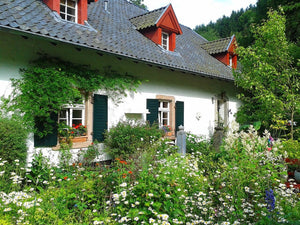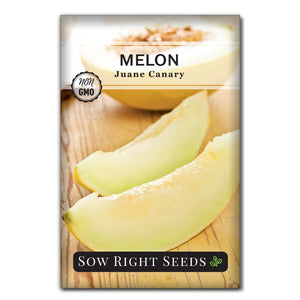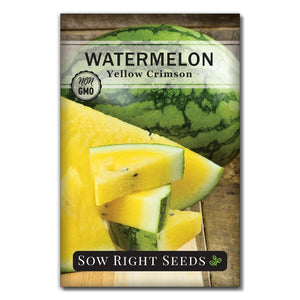Growing Bitter Melon: Easy Tips for a Reliable Garden Harvest
MelonsBitter melon is a distinct and staple ingredient in Asian and Indian dishes. It is growing in popularity in the US, but finding it can still be hit or miss in specialty grocery stores. However, bitter melon is easy to grow from seed. By growing bitter melon in your own garden, you’ll have an abundant harvest to enjoy and share to introduce others to this unique fruit.

Bitter melon is also known as bitter gourd, balsam-pear, bitter squash, and sopropo. In India, it is called Karela, and in Japan, it is called Nigauri. Like melons and squash, bitter melon is a member of the cucurbit family.
There are two main types of bitter melon: the Chinese variety and the Indian variety. The Indian type has a warty or bumpy exterior and tapered ends. The Chinese type looks more like a cucumber and has smoother ridges. Although they look different, they grow similarly and have a similar taste and health benefits.
Bitter melon is reasonably easy to grow. In our Missouri garden, it did well, and we had a prolific harvest without any pest problems. The warm, humid midwestern summer proved to be the right growing environment for bitter melon.
If you want a reliable supply of bitter melons, follow these tips to grow bitter melons in your own garden.

How to Grow Bitter Melon from Seed
Bitter melon can be grown from seeds started indoors or directly sown outside. It grows in warm, subtropical climates and will do best in similar growing conditions. Wait until temperatures are above 70ºF before planting outdoors. Sow seeds in rich, well-draining soil and provide vertical support.
Bitter Melon Seed Germination Tips
Bitter melon seeds have a distinctive shape. They also have a tough outer coating. Bitter melon seeds will germinate faster if this protective coating is weakened. We recommend scarification and soaking the seeds before planting. An effective way to scarify bitter melon seeds is to clip off a piece of the outer coating with nail clippers. You can also rough up the hard shell with a file. Then, soak the seeds in warm water for 24 hours. Once planted, keep the seeds moist and the soil warm, and they will germinate in 7 to 14 days.
Scarify bitter melon seeds and soak them in warm water for 24 hours before planting.
Plant seeds 1/2 inch deep.
Use a heat mat to keep soil temperature between 70 and 85ºF.
For indoor bitter melon seedlings, place a grow light several inches above the seedlings.

Bitter Melon Seedlings
Once bitter melon seedlings have several true leaves, they can be transplanted outdoors. Wait until all danger of frost has passed. Harden off seedlings before transplanting them outdoors. Space bitter melon plants 18 to 24 inches apart.

Growing Bitter Melon
Bitter melon thrives in hot, humid climates. Give your plants rich soil, plenty of water, and a strong trellis to grow on. Like cucumbers, bitter melon plants will have male and female flowers. The male flowers will show up first. The female flowers will have a small fruit behind the flower. Once the flower is pollinated, the fruit can fully develop. Male flowers will naturally fall off in a day or two. But the female flowers will remain. If female flowers fall off, it could be a sign of failed pollination. You can use hand pollination methods or increase the amount of beneficial pollinators in your garden.
Sun
Bitter melon thrives in full sun. Make sure your plants receive at least 6 to 8 hours of sunlight daily. If the plants are slow to grow or have few flowers, it could indicate insufficient sun.

Soil
Give your plants nutrient-rich, well-draining soil. Add some well-rotted compost to your garden before transplanting or planting bitter melon seeds.
Water
Water is crucial for maturing fruits. It’s recommended to give plants at least an inch of water each week.
Trellis
A trellis is very beneficial for growing bitter melon plants. The vines can get quite long, and a trellis allows for better air circulation and easier harvesting. Put in your trellis when planting your seeds or transplanting seedlings to avoid damaging the plant roots later.

When to Harvest Bitter Melon
Bitter melon gets more bitter with age, so it is usually harvested when it is young and green. This is also when it has its full nutritional value. The skin is shiny and green at this stage, and the flesh is firm and crisp. If it gets overripe, it will have a softer texture and turn yellow or orange. The texture will become pithy, much like an overripe cucumber.
Harvest bitter melon fruits often to keep the plants producing. If fruits are left on the vine, they will eventually split open and drop their seeds.
The vines and leaves can get quite thick, and the fruits blend into the foliage. You'll be glad you have a trellis when looking through leaves to find ripe fruits.
The bitter flavor can be mellowed with cooking and is often steamed, boiled, stuffed, and pickled.

Pests and Diseases
One of the benefits of growing bitter melon is that it isn’t as susceptible to pests and diseases that bother other cucurbits. Also, deer and rabbits leave it alone because of its bitter flavor.
Watch for cucumber beetles and aphids, especially when the plants are young. Powdery mildew and other fungi can be a problem in high humidity.

Bitter Melon/Bitter Gourd FAQs
What is bitter gourd called in the USA?
In the USA, bitter gourd is commonly referred to as bitter melon. It goes by various names in different cultures, such as karela in Hindi, goya in Japanese, and ku gua in Mandarin. Regardless of the name, this unique vegetable is known for its distinctively bitter taste and numerous health benefits.
What is bitter gourd good for?
The name Bitter gourd, or bitter melon, might give you pause. Why eat something so bitter? Many people enjoy the bitter flavor, while others are more interested in its impressive health benefits. Bitter melon is packed with essential nutrients, including vitamins A, C, and several B vitamins. It's also rich in minerals like iron, calcium, and potassium. Bitter melon is particularly celebrated for its ability to regulate blood sugar levels, making it a valuable dietary addition for those managing diabetes. It has also been used traditionally for arthritis pain and fighting inflammation. Currently, there are studies examining bitter melon’s cancer-fighting abilities.
Source: St. Louis University.
How long does it take to grow bitter melon?
Bitter melon takes about 70 to 90 days to go from seed to harvest. The exact time frame can vary depending on factors such as the weather and soil conditions. Bitter melon thrives in warm temperatures and full sunlight, so ensuring optimal growing conditions can help you achieve a successful harvest within this timeframe.
Does bitter melon need a trellis?
Bitter melon plants benefit significantly from being grown on a trellis. As a climbing vine, bitter melon needs support to grow upwards, which helps maximize space and improves air circulation around the plants. A sturdy trellis also makes harvesting easier and prevents the fruits from touching the ground. Fruits on the ground have an increased risk of rot and pest infestations. Providing a trellis allows bitter melon plants to thrive and produce healthy, high-quality fruits.
Where is the best place to plant bitter melon?
The best place to plant bitter melon is in a location that receives full sunlight for at least six to eight hours daily. Choose a spot with well-drained, fertile soil enriched with organic matter. Bitter melon thrives in warm temperatures, so it's ideal to plant it after the last frost has passed and the soil has warmed up. If you're growing bitter melon in a cooler climate, consider starting seeds indoors and transplanting them outside once the weather is consistently warm.
Bitter melon is a unique and valued vegetable in Indian and Asian cuisine. Growing bitter melon can be a rewarding experience, offering a unique addition to your garden and a plethora of health benefits. By understanding its needs and providing the right conditions, you can enjoy a bountiful harvest of this remarkable vegetable. Grow bitter melon from seed in your garden for a unique flavor.








Leave a comment